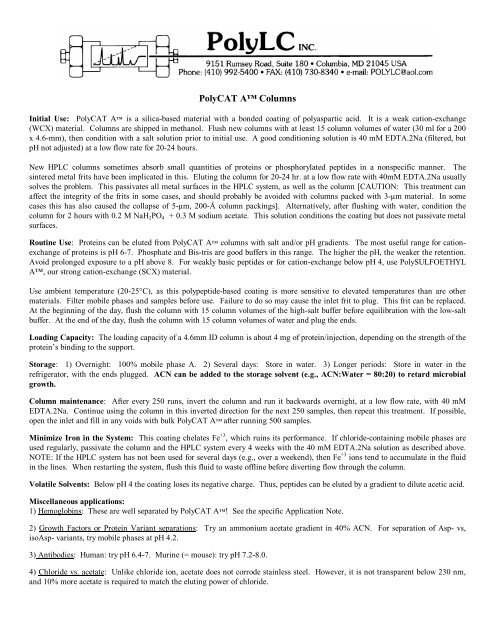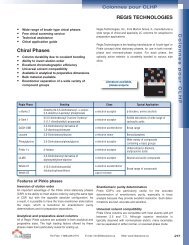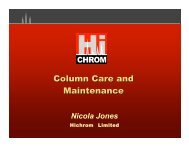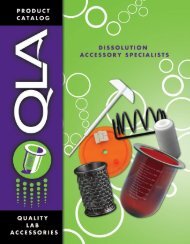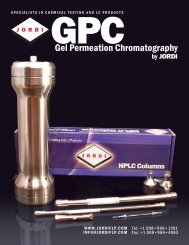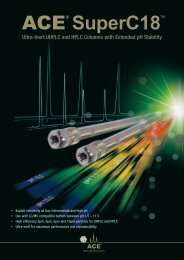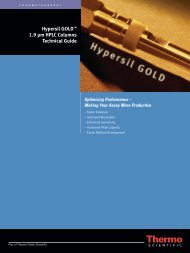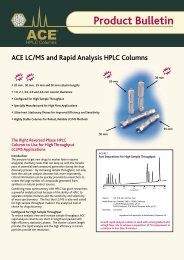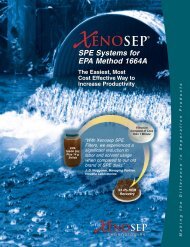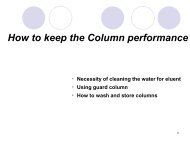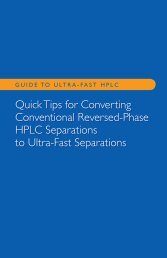You also want an ePaper? Increase the reach of your titles
YUMPU automatically turns print PDFs into web optimized ePapers that Google loves.
<strong>PolyCAT</strong> A <strong>Columns</strong>Initial Use: <strong>PolyCAT</strong> A is a silica-based material with a bonded coating of polyaspartic acid. It is a weak cation-exchange(WCX) material. <strong>Columns</strong> are shipped in methanol. Flush new columns with at least 15 column volumes of water (30 ml for a 200x 4.6-mm), then condition with a salt solution prior to initial use. A good conditioning solution is 40 mM EDTA.2Na (filtered, butpH not adjusted) at a low flow rate for 20-24 hours.New HPLC columns sometimes absorb small quantities of proteins or phosphorylated peptides in a nonspecific manner. Thesintered metal frits have been implicated in this. Eluting the column for 20-24 hr. at a low flow rate with 40mM EDTA.2Na usuallysolves the problem. This passivates all metal surfaces in the HPLC system, as well as the column [CAUTION: This treatment canaffect the integrity of the frits in some cases, and should probably be avoided with columns packed with 3-µm material. In somecases this has also caused the collapse of 5-µm, 200-Å column packings]. Alternatively, after flushing with water, condition thecolumn for 2 hours with 0.2 M NaH 2 PO 4 + 0.3 M sodium acetate. This solution conditions the coating but does not passivate metalsurfaces.Routine Use: Proteins can be eluted from <strong>PolyCAT</strong> A columns with salt and/or pH gradients. The most useful range for cationexchangeof proteins is pH 6-7. Phosphate and Bis-tris are good buffers in this range. The higher the pH, the weaker the retention.Avoid prolonged exposure to a pH above 8. For weakly basic peptides or for cation-exchange below pH 4, use PolySULFOETHYLA, our strong cation-exchange (SCX) material.Use ambient temperature (20-25°C), as this polypeptide-based coating is more sensitive to elevated temperatures than are othermaterials. Filter mobile phases and samples before use. Failure to do so may cause the inlet frit to plug. This frit can be replaced.At the beginning of the day, flush the column with 15 column volumes of the high-salt buffer before equilibration with the low-saltbuffer. At the end of the day, flush the column with 15 column volumes of water and plug the ends.Loading Capacity: The loading capacity of a 4.6mm ID column is about 4 mg of protein/injection, depending on the strength of theprotein’s binding to the support.Storage: 1) Overnight: 100% mobile phase A. 2) Several days: Store in water. 3) Longer periods: Store in water in therefrigerator, with the ends plugged. ACN can be added to the storage solvent (e.g., ACN:Water = 80:20) to retard microbialgrowth.Column maintenance: After every 250 runs, invert the column and run it backwards overnight, at a low flow rate, with 40 mMEDTA.2Na. Continue using the column in this inverted direction for the next 250 samples, then repeat this treatment. If possible,open the inlet and fill in any voids with bulk <strong>PolyCAT</strong> A after running 500 samples.Minimize Iron in the System: This coating chelates Fe +3 , which ruins its performance. If chloride-containing mobile phases areused regularly, passivate the column and the HPLC system every 4 weeks with the 40 mM EDTA.2Na solution as described above.NOTE: If the HPLC system has not been used for several days (e.g., over a weekend), then Fe +3 ions tend to accumulate in the fluidin the lines. When restarting the system, flush this fluid to waste offline before diverting flow through the column.Volatile Solvents: Below pH 4 the coating loses its negative charge. Thus, peptides can be eluted by a gradient to dilute acetic acid.Miscellaneous applications:1) Hemoglobins: These are well separated by <strong>PolyCAT</strong> A! See the specific Application Note.2) Growth Factors or Protein Variant separations: Try an ammonium acetate gradient in 40% ACN. For separation of Asp- vs,isoAsp- variants, try mobile phases at pH 4.2.3) Antibodies: Human: try pH 6.4-7. Murine (= mouse): try pH 7.2-8.0.4) Chloride vs. acetate: Unlike chloride ion, acetate does not corrode stainless steel. However, it is not transparent below 230 nm,and 10% more acetate is required to match the eluting power of chloride.
5) Mixed-mode effects: When the mobile phase contains over 60% organic solvent, then hydrophilic interactions will besuperimposed on the electrostatic effects. <strong>PolyCAT</strong> A can then resolve many peptides that differ in polarity but not charge (e.g.,methylation of a Lys- residue). It may be necessary to use a gradient salt with good solubility in org. solvents, such as sodiumperchlorate or triethylamine phosphate (TEAP).


